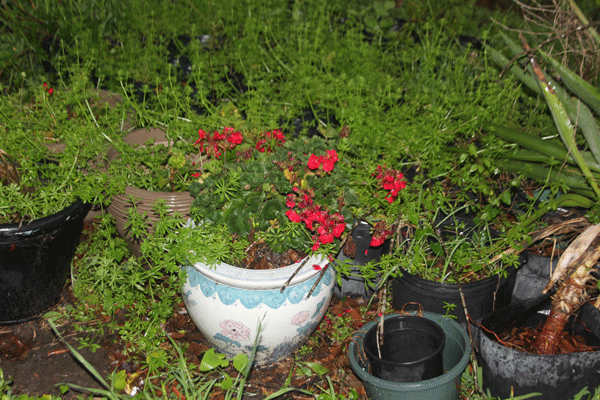Photo: Geranium (actually genus Pelargonium) after winter in South Texas.
Winter in our area continues to become milder. When I was a child, several decades ago, we had winters with real freezes, several of them a year. (By the way, when did we quit capitalizing seasons and directions?) A typical winter had several killing freezes. Grasshoppers and butterflies didn’t survive winter as adults. This winter we had butterflies flitting around every week and adult grasshoppers were mating and laying eggs in March. Plants such as Norfolk Island pines (Araucaria heterophylla), common house ivy or Pothos (Epipremnum aureum) and Philodendron didn’t survive outside through the winter. Today all three thrive year round in our yard.
A prime example of how mild our winters have become is the Geranium in the photo. Carl, our son, and his family moved to the farm last summer from Austin in Central Texas. They brought with them a number of houseplants, which, in Austin, required overwintering inside their house. These plants remained in our yard as their abode was constructed (and later due to three new rescue puppies that loved destroying plants). I didn’t bother to bring the plants into the greenhouses. They stayed in the yard without protection through our three cold spells and flirtations with freezes. My thermometer actually said it reached 32°F one morning for a few minutes. There was no evidence other than the thermometer reading that this occurred.
The warmer climate has consequences such as mosquitoes in January. Other changes include the northward expansion of plant and animal ranges. When I was a child you’d have to drive four hours south to see a Mexican eagle (Caracara cheriway), whistling duck (Dendrocygna autumnalis), green jay (Cyanocorax yncas), honey wasps (Brachygastra lecheguana), and many other animals.
In the 1960s, huisache (Vachellia farnesiana var. farnesiana), a brushy tree, made it to the farm, but no farther north. Today it can be found 200 miles north of here. Eucalyptus trees weren’t used as landscaping plants due to winter damage and/or death. Today they are becoming common yard trees and are used in major cities along highways for decoration and noise control.
Sure, we have the occasional, rare cold snap. Once since 2001 we dropped into the teens (17°F to be precise). But, these are fewer and farther between. This area is becoming sub-tropical and, if things don’t change, eventually tropical. Along with that change are tropical diseases. Dengue fever is only hours south. Kissing bugs (Triatoma sp.) that carry Chagas disease are now common here. In fact, Carl and I found one yesterday while cleaning up some scrap wood. These bugs require a nocturnal blood meal for the production of eggs. They eerily stalk mammals such as our dogs and even us to get a meal. One night at bedtime I entered our bedroom to see one stalk Susie, my wife, as she read a book. The bug was half way from the foot of the bed to Susie’s head. Their preferred feeding site is lips. They bite to draw blood which they lap up. Chagas disease (Trypanosoma cruzi), a nasty parasite that causes liver and brain damage leading eventually to death, is spread when the equally nasty kissing bug defecates while feeding. The bite causing itching and when the sleeping person scratches the itch that spreads the disease organisms from the feces into the new victim’s bloodstream. Nature can be very creepy…
In any event, climate change (really warming) is happening and the results are discernable in my lifetime. I wonder how much things will change during the lives of my grandchildren.


Leave a Reply